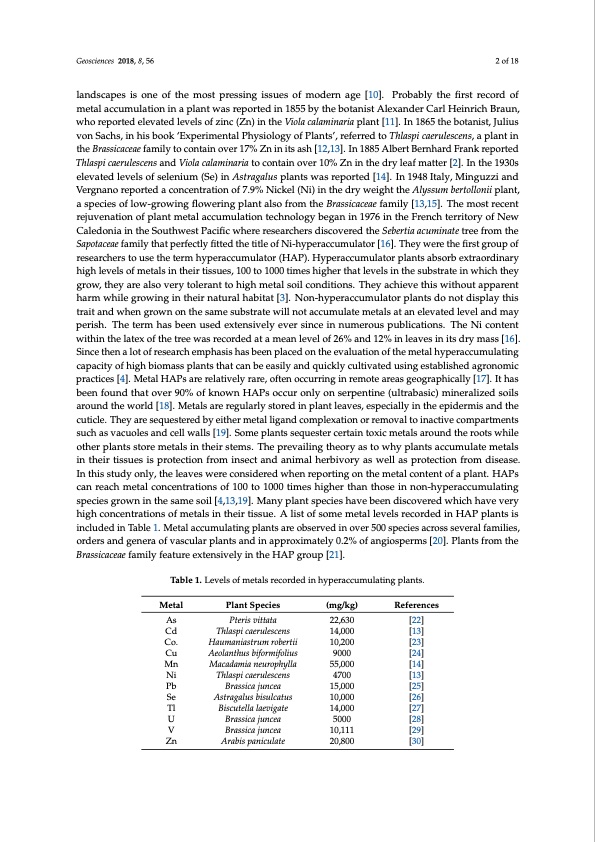
PDF Publication Title:
Text from PDF Page: 002
Geosciences 2018, 8, 56 2 of 18 landscapes is one of the most pressing issues of modern age [10]. Probably the first record of metal accumulation in a plant was reported in 1855 by the botanist Alexander Carl Heinrich Braun, who reported elevated levels of zinc (Zn) in the Viola calaminaria plant [11]. In 1865 the botanist, Julius von Sachs, in his book ‘Experimental Physiology of Plants’, referred to Thlaspi caerulescens, a plant in the Brassicaceae family to contain over 17% Zn in its ash [12,13]. In 1885 Albert Bernhard Frank reported Thlaspi caerulescens and Viola calaminaria to contain over 10% Zn in the dry leaf matter [2]. In the 1930s elevated levels of selenium (Se) in Astragalus plants was reported [14]. In 1948 Italy, Minguzzi and Vergnano reported a concentration of 7.9% Nickel (Ni) in the dry weight the Alyssum bertollonii plant, a species of low-growing flowering plant also from the Brassicaceae family [13,15]. The most recent rejuvenation of plant metal accumulation technology began in 1976 in the French territory of New Caledonia in the Southwest Pacific where researchers discovered the Sebertia acuminate tree from the Sapotaceae family that perfectly fitted the title of Ni-hyperaccumulator [16]. They were the first group of researchers to use the term hyperaccumulator (HAP). Hyperaccumulator plants absorb extraordinary high levels of metals in their tissues, 100 to 1000 times higher that levels in the substrate in which they grow, they are also very tolerant to high metal soil conditions. They achieve this without apparent harm while growing in their natural habitat [3]. Non-hyperaccumulator plants do not display this trait and when grown on the same substrate will not accumulate metals at an elevated level and may perish. The term has been used extensively ever since in numerous publications. The Ni content within the latex of the tree was recorded at a mean level of 26% and 12% in leaves in its dry mass [16]. Since then a lot of research emphasis has been placed on the evaluation of the metal hyperaccumulating capacity of high biomass plants that can be easily and quickly cultivated using established agronomic practices [4]. Metal HAPs are relatively rare, often occurring in remote areas geographically [17]. It has been found that over 90% of known HAPs occur only on serpentine (ultrabasic) mineralized soils around the world [18]. Metals are regularly stored in plant leaves, especially in the epidermis and the cuticle. They are sequestered by either metal ligand complexation or removal to inactive compartments such as vacuoles and cell walls [19]. Some plants sequester certain toxic metals around the roots while other plants store metals in their stems. The prevailing theory as to why plants accumulate metals in their tissues is protection from insect and animal herbivory as well as protection from disease. In this study only, the leaves were considered when reporting on the metal content of a plant. HAPs can reach metal concentrations of 100 to 1000 times higher than those in non-hyperaccumulating species grown in the same soil [4,13,19]. Many plant species have been discovered which have very high concentrations of metals in their tissue. A list of some metal levels recorded in HAP plants is included in Table 1. Metal accumulating plants are observed in over 500 species across several families, orders and genera of vascular plants and in approximately 0.2% of angiosperms [20]. Plants from the Brassicaceae family feature extensively in the HAP group [21]. Table 1. Levels of metals recorded in hyperaccumulating plants. Metal As Cd Co. Cu Mn Ni Pb Se Tl U V Zn Plant Species Pteris vittata Thlaspi caerulescens Haumaniastrum robertii Aeolanthus biformifolius Macadamia neurophylla Thlaspi caerulescens Brassica juncea Astragalus bisulcatus Biscutella laevigate Brassica juncea Brassica juncea Arabis paniculate (mg/kg) References 22,630 [22] 14,000 [13] 10,200 [23] 9000 [24] 55,000 [14] 4700 [13] 15,000 [25] 10,000 [26] 14,000 [27] 5000 [28] 10,111 [29] 20,800 [30]PDF Image | Induced Plant Accumulation of Lithium

PDF Search Title:
Induced Plant Accumulation of LithiumOriginal File Name Searched:
geosciences-08-00056.pdfDIY PDF Search: Google It | Yahoo | Bing
Product and Development Focus for Infinity Turbine
ORC Waste Heat Turbine and ORC System Build Plans: All turbine plans are $10,000 each. This allows you to build a system and then consider licensing for production after you have completed and tested a unit.Redox Flow Battery Technology: With the advent of the new USA tax credits for producing and selling batteries ($35/kW) we are focussing on a simple flow battery using shipping containers as the modular electrolyte storage units with tax credits up to $140,000 per system. Our main focus is on the salt battery. This battery can be used for both thermal and electrical storage applications. We call it the Cogeneration Battery or Cogen Battery. One project is converting salt (brine) based water conditioners to simultaneously produce power. In addition, there are many opportunities to extract Lithium from brine (salt lakes, groundwater, and producer water).Salt water or brine are huge sources for lithium. Most of the worlds lithium is acquired from a brine source. It's even in seawater in a low concentration. Brine is also a byproduct of huge powerplants, which can now use that as an electrolyte and a huge flow battery (which allows storage at the source).We welcome any business and equipment inquiries, as well as licensing our turbines for manufacturing.| CONTACT TEL: 608-238-6001 Email: greg@infinityturbine.com | RSS | AMP |